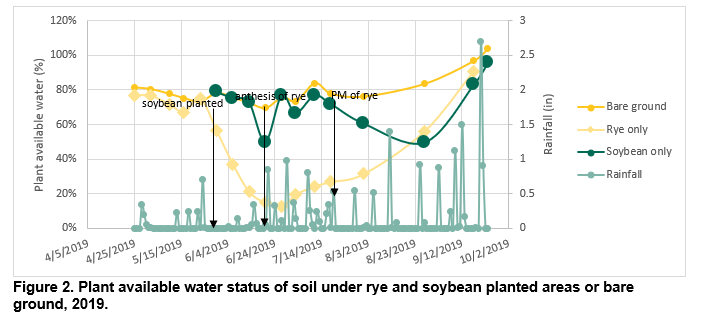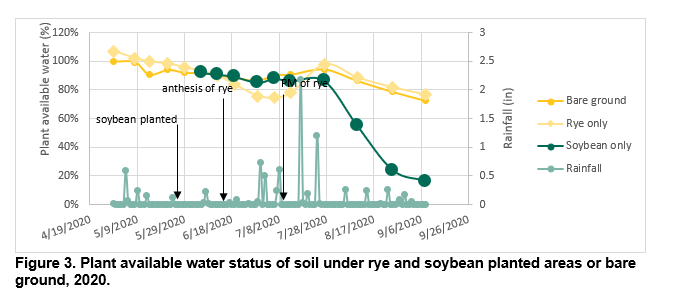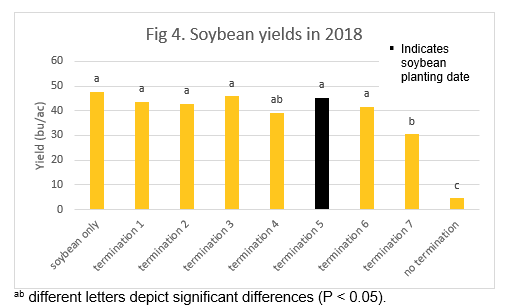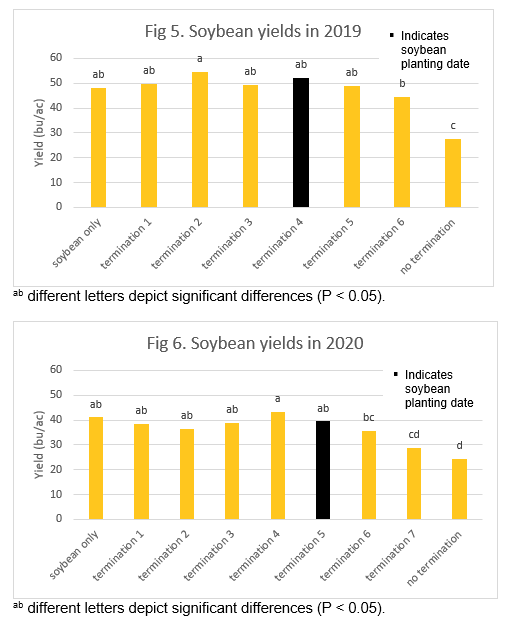Introduction
Rye use as a cover crop prior to soybeans is a new trend that is being adopted in North Dakota. Rye makes up for a lot of weaknesses that soybeans have in a cropping system. Some of the primary benefits include reducing soil erosion, increased weed control, additional grazing/forage material, utilization of excess soil moisture by rye, allowing soybean to be planted timely, and allowing soybeans to be planted further into former saline regions. In this system winter rye is planted the fall before soybeans. The rye is terminated prior to or shortly after soybean planting. Rye is best terminated with glyphosate.
Rye provides selective weed suppression, meaning that it is more effective against some species than others. Rye is particularly effective at suppressing kochia (up to 70% control in a heavy kochia infestation), and also does well against pigweed species, ragweed, and yellow foxtail. Rye has very little or no suppression of mint species (like lanceleaf sage) or most legumes. Thus, soybeans are not influenced by the presence of rye, except when moisture is limiting. How limiting is the rye water depletion to soybean yields and when should rye be terminated?
Project description
A trial was conducted from 2018 to 2020 to monitor soil moisture status in growing rye plots using a hydroprobe. To attribute soil moisture depletion to crops, rainfall data from the nearby NDAWN station and moisture data collected from bare ground plots scattered throughout the trial area were used. The data from the bare ground plots established a baseline soil moisture status where changes were affected only by climatic factors and soil physical properties. Because this study did not determine whether moisture lost from the bare ground plots would have been lost at the same rate from rye-planted plots, a range for the actual crop water use of rye is given. After careful calibration of the hydroprobe, data show how the growing rye affected soil moisture status throughout each growing season. In 2018, field capacity and permanent wilting point values were obtained for the trial area and were used to calculate the amount of plant-available water. In this trial, plots were planted to rye or soybean only and soybean was planted into plots where rye was grown. The main treatments in this trial were different termination dates of the rye cover crop. Termination dates started at the green-up of rye and followed on a weekly basis with the last treatment as rye that was allowed to mature in the soybean. Soil moisture data was taken weekly starting with rye green-up until rye harvest, then continued bi-weekly until soybean harvest.
This trial will likely run for one more season. This article will present the effects of rye on soil moisture changes up until maturity in comparison with the moisture status of pure soybean plots and bare ground areas. Soybean yields are presented from all rye termination treatments.
Soil moisture depletion by rye
Soil moisture depletion by rye varied greatly by year, but in each of the years the moisture level of the rye plots was significantly lower than those of the bare ground areas at rye physiological maturity (PM).
In 2018, at rye PM, the rye plots had 26% plant available water (PAW), compared to 89% in bare ground and 76% in the soybean-only plot. That year started out with a moisture deficit and only had around 55% PAW once the soil thawed (Fig. 1).
In 2019, at rye PM, the rye plots held 27% PAW, while the bare ground had 78% and the soybean plots had 72%. The season started with 80% PAW (Fig. 2).
In the spring of 2020, the soil took a long time to drain all the excess moisture that had accumulated during the previous fall and winter. That excess water drained slowly as the soil thawed while the rye was already growing on the surface. At rye PM, the rye plots held 78% PAW, while bare ground held 91% and the soybean plots held 86% (Fig. 3).
Figures 1 through 3 show that ultimately the crop water use of rye is miniscule compared to that of the soybean crop. The reason that it’s still a factor is that there is a period of time around anthesis when the rye aggressively uses water compared to the rest of its life cycle. During that time the soybean is still in its early stages of development and is vulnerable to microenvironment effects in the seed zone.
The effect of rye termination timing on soybean yields
The current recommendation is for rye cover crop termination at least 10 days before soybean planting. One of the objectives of this study and other similar studies at our location was to determine whether this recommendation should be updated.
The good news is there was no significant yield difference between plots where rye was terminated at or before soybean planting in any of the trial years. On the other hand, in all three years there was a large reduction in soybean yield when the rye was allowed to reach maturity within the soybean, to the point of complete crop failure in 2018 (Fig 4-6). There was substantial yield loss even in 2020, when early-season soil moisture was abundant (Fig 3). Furthermore, in all three years, letting rye grow for two weeks after soybean planting, resulted in statistically significant yield reduction. Letting the rye grow for only 1 week also showed a decrease in yield for each of the years compared to terminating at or before planting, but this difference was not statistically significant (Fig 4-6).
So far the data from this trial show that at the climatic conditions typical in the Carrington, ND, area with 18.79 inches of average annual precipitation (US Climate Data, 2020), it is safe to allow rye to grow until soybean planting. However, letting it grow even a week beyond that can be risky, and letting it get to full maturity within the soybean can lead to crop failure in some years.
Partial funding for this project was provided by the North Dakota Soybean Council.





